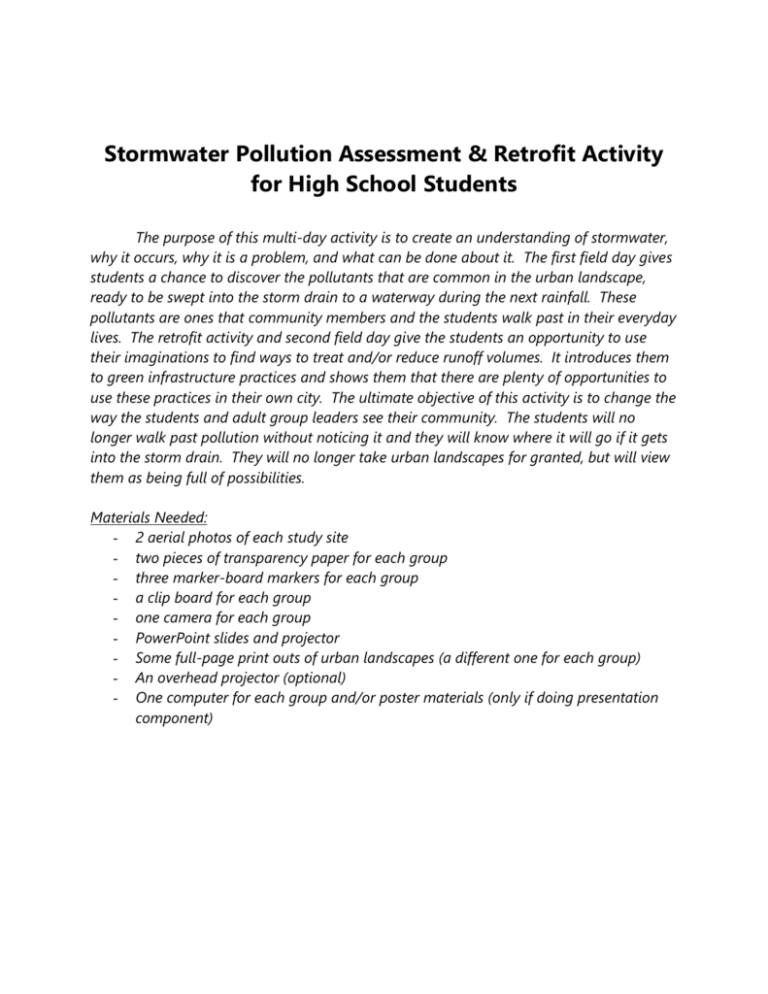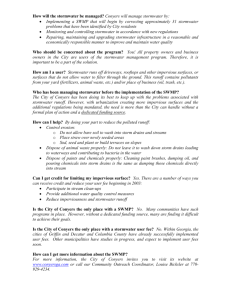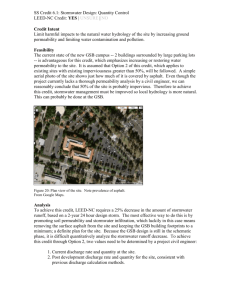Stormwater Pollution Assessment and Retrofit Brainstorming Project
advertisement

Stormwater Pollution Assessment & Retrofit Activity for High School Students The purpose of this multi-day activity is to create an understanding of stormwater, why it occurs, why it is a problem, and what can be done about it. The first field day gives students a chance to discover the pollutants that are common in the urban landscape, ready to be swept into the storm drain to a waterway during the next rainfall. These pollutants are ones that community members and the students walk past in their everyday lives. The retrofit activity and second field day give the students an opportunity to use their imaginations to find ways to treat and/or reduce runoff volumes. It introduces them to green infrastructure practices and shows them that there are plenty of opportunities to use these practices in their own city. The ultimate objective of this activity is to change the way the students and adult group leaders see their community. The students will no longer walk past pollution without noticing it and they will know where it will go if it gets into the storm drain. They will no longer take urban landscapes for granted, but will view them as being full of possibilities. Materials Needed: - 2 aerial photos of each study site - two pieces of transparency paper for each group - three marker-board markers for each group - a clip board for each group - one camera for each group - PowerPoint slides and projector - Some full-page print outs of urban landscapes (a different one for each group) - An overhead projector (optional) - One computer for each group and/or poster materials (only if doing presentation component) Day One: In Classroom - What is Stormwater? Impervious surfaces and runoff How rainwater gets from the city to a water body Stormwater pollution and specific pollutants Introduction to the project, timeline, materials provided and needed, group tasks What will we be looking for: potential pollutants on the land’s surface Specific Instructions on conducting the Street & Storm Drain Assessment and the Hotspot Investigation Study areas Ground rules The purpose of day one is to create an understanding of what stormwater is, that it is the result of development (impervious surfaces), that it travels from our cities to our lakes and rivers through storm drains, and that it carries pollution with it from our cities to our rivers and lakes. This day is also used to introduce and explain the activities and expectations of day two. Day Two: Field Day - Street and Storm Drain Assessment - Hotspot Site Investigation Give each group of students an aerial photo of their study site with a piece of transparency paper over it on the clip board. Have each group of students walk their study site with an adult member. As they walk they should be noticing the pollution on the curbs and drains and other impervious surfaces in the site (i.e. parking lots, sidewalks, driveways, etc). They should also be keeping their eyes open for stormwater hotspots. Have the students work together to take pictures, describe pollutants, and mark where hotspots are found on their maps. The adult group member may need to get things going by giving hints or pointing out some pollutants, but the students should catch on shortly. Day Three : In Classroom - Briefly review what we learned on day one, particularly impervious surfaces - Lead them to the conclusion that imperviousness is the stormwater culprit so reducing imperviousness must be the solution; introduce the concept of ‘green infrastructure’ - Break green infrastructure into two groups: practices for treating stormwater and practices for reducing runoff volume - - Explain in some depth the following practices, how they work, where they fit into the landscape, etc: swales, infiltration basins (including rain gardens), trees and shrubs, deep rooted plants, stormwater planters, green roofs, rain barrels Introduce the activity Find pictures of urban landscapes (i.e. a strip mall, an aerial photo of a grocery store, a residential home (that shows downspouts), etc. Print each landscape on a full piece of paper. Paperclip a piece of transparency paper over each landscape and give each group a different landscape and a handout showing examples of each of the practices that you just explained (swales, infiltration basins, trees and shrubs, deeprooted plants, stormwater planters, green roofs, and rain barrels). Have the groups work together to think about where on their landscape runoff is coming from (draw in with one color marker) and where it is flowing (draw in with another color) . Have them find where there might be wasted space that could be utilized for a stormwater practice (i.e. parking lot islands, rooftops, etc). With a marker, have them apply as many of the stormwater management practices as they can on their landscape. Don’t worry about practicality, let them use their imaginations! Have one or two students from each group come up and tell the rest of the class about the origins and flow direction of runoff on their landscape, and what practices they applied to manage the runoff. (If you can, align each transparency onto the landscape image using a power point projector and an overhead projector). - Now introduce the next day’s activity. It will be the same as today’s exercise, but they will be doing it at their study sites. Remind them to notice where runoff originates and where it will flow to. Have them look for wasted spaces in the landscape, and apply practices accordingly. Day Four : Field Day - Stormwater Management Retrofit Activity Give each group of students a fresh aerial photo of their site. Have each group of students walk the site with an adult group member. They should choose specific sites along the way to outfit with stormwater practices (i.e. a bank, a church, a block of homes, the boulevard space between the street and sidewalk, a parking lot, a gas station, etc). Have them take lots of pictures of the site, mark the site on their map, and describe and/or sketch the practices that they would apply to the landscape. Day Five : In Classroom - Prepare ahead of time for posters: a copy of each aerial photo with transparency markings (one with hotspots, one with retrofits), urban landscape photos with - - markings, many student photo print-outs of pollutants and retrofit sites, group photos of the students. (Prepare digital slides for use in PowerPoint). Have each group of students work together to develop a few PowerPoint slides and/or a poster depicting some of the pollutants that they found on the streets and storm drains, some potential hotspots, and a few sites that could be retrofitted with stormwater management practices (only if going to present). If there is time, have the groups come together as a class and tell each other about their slides. Discuss together the project as a whole. Optional Activities: - If there is a stormwater management practice nearby, bring the class out to it at the end of day three if there is time. Explain where the runoff originates, how it flows to this practice, and specific information about this type of practice (point out sizing, overflow, treatment capabilities). - Have one or two students from each group present the results of their project to a group of decision-makers (administrators, council members, school board, etc) Language to Use - curb-cut - “water doesn’t flow up curbs” - retrofit







